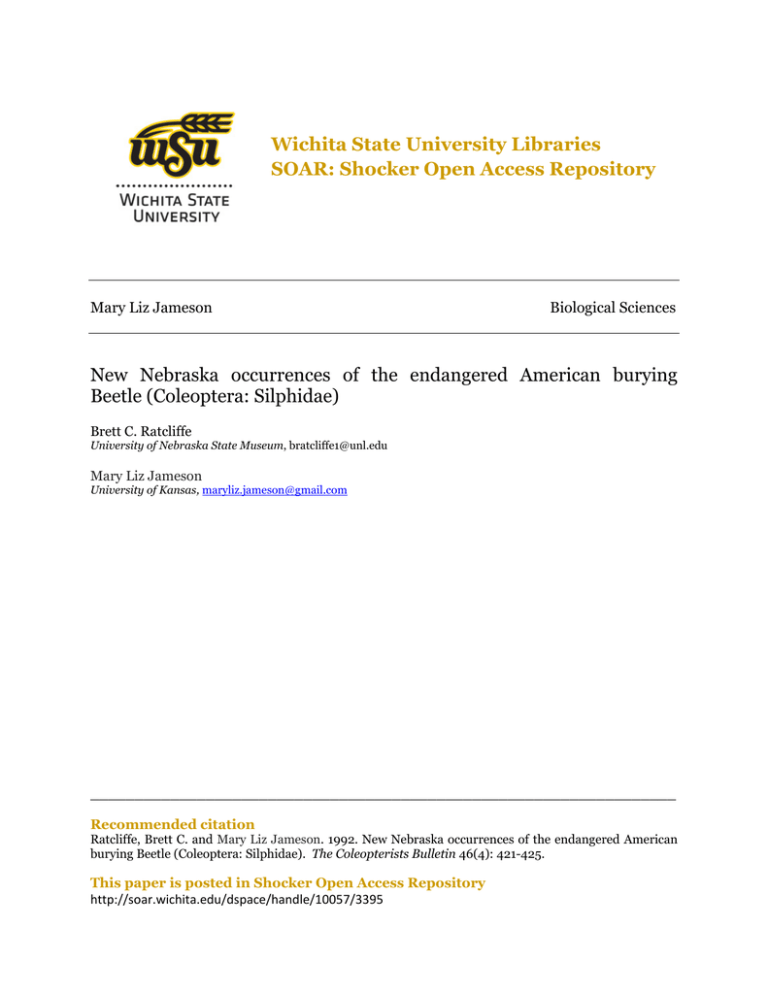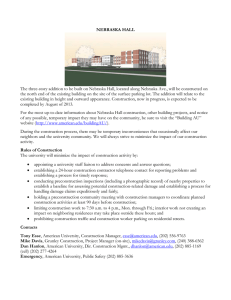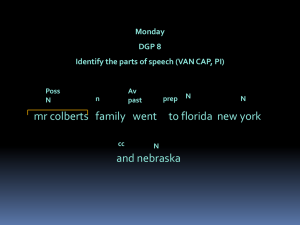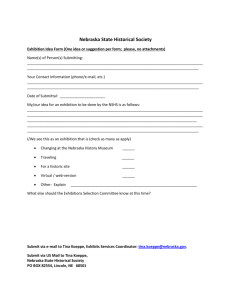Wichita State University Libraries SOAR: Shocker Open Access Repository
advertisement

Wichita State University Libraries SOAR: Shocker Open Access Repository Mary Liz Jameson Biological Sciences New Nebraska occurrences of the endangered American burying Beetle (Coleoptera: Silphidae) Brett C. Ratcliffe University of Nebraska State Museum, bratcliffe1@unl.edu Mary Liz Jameson University of Kansas, maryliz.jameson@gmail.com __________________________________________________________________ Recommended citation Ratcliffe, Brett C. and Mary Liz Jameson. 1992. New Nebraska occurrences of the endangered American burying Beetle (Coleoptera: Silphidae). The Coleopterists Bulletin 46(4): 421-425. This paper is posted in Shocker Open Access Repository http://soar.wichita.edu/dspace/handle/10057/3395 The Coleopterists Bulletin, 46(4):421-425. 1992. NEW NEBRASKA OCCURRENCES OF THE ENDANGERED AMERICAN BURYING BEETLE (COLEOPTERA: SILPHIDAE) BRErr C. RATCLIFFE W436 Nebraska Hall, University of Nebraska State Museum, Lincoln, NE 68588-0514 AND MARY Liz JAMESON Snow Entomological Museum, University of Kansas, Lawrence, KS 66045-2119 ABSTRACT Six new recordsfor the endangeredAmericanburyingbeetle,Nicrophorusamericanus Olivier, are reportedfrom the NebraskaSandhills.Nebraskais one of only four states in the United States where this beetle remainsextant. In the 1980s, entomologists documented the decreasing abundance of Nicrophorus americanus Olivier (Fig. 1), the American burying beetle, across North America (Anderson 1982; Davis 1980; Kozol et al. 1988). Since that time, beetles of this species have not been collected or sighted in the United States except for the known and widely separated populations in eastern Oklahoma, Block Island in Rhode Island, a single male specimen taken in westcentral Nebraska in 1988, and a populations discovered at Ft. Chaffee Military Reservation (Sebastian Co., Arkansas) in 1992. In 1983, N. americanus was included in the IUCN Invertebrate Red Book as an endangered species (Wells et al. 1983). It was proposed as an endangered species in the United States Federal Register in 1988 (Recce 1988) and was placed on the Endangered Species List on 14 August 1989. We report here the recent occurrence of six additional specimens of N. americanus from Nebraska. The first specimen, a male, was found dead in the bottom of a small boat on the northwest shore of North Marsh Lake at the Valentine National Wildlife Refuge due south of Valentine, Cherry County, Nebraska. The dead and partially eaten specimen was collected on 29 April 1992 by L. L. McDaniel, Wildlife Biologist for the USFWS. We believe that it probably died the preceding fall or winter. We infer this based on its extremely desiccated, hence aged, condition as well as the fact that the weather in late April in north-central Nebraska is still too cold to allow for much insect activity. Specimens previously taken in Nebraska show a temporal activity of June (2), July (4), August (2), September (1). Whether the beetle sought shelter in the boat and became trapped there or was taken there and partially eaten by a rodent remains unknown. The specimen has been deposited in the Systematics Research Collections of the University of Nebraska State Museum. Two additional American burying beetles were taken in two separate small 421 422 THE COLEOPTERISTS BULLETIN 46(4), 1992 Fig.1. Habitu of N. americanus.. Fig. 1. Habitusof N. americanus. THE COLEOPTERISTS BULLETIN 46(4), 1992 423 mammal pitfall traps (five gallon buckets) at the east end of Dewey Lake, also on the refuge, and four miles west of where the Marsh Lake specimen was found. They were collected on 7 June 1992 by Michael S. Shipman and Mylea Petersburg (National Ecology Research Center, USFWS). Both specimens were released alive; their sexes were not determined. Finally, three specimens were found dead on 10 July (1) and 13 July 1992 (2) at South Marsh Lake and Middle Marsh Lake, respectively, on the refuge by L. L. McDaniel. They were found inside three separate, double-funnel, wire mesh snake traps that are used to control bullsnakes that prey on duck eggs. Two of the snake traps contained dead snakes while the third was empty. The sexes of the beetles were not determined. These three specimens are currently being conserved at the refuge headquarters. The relatively large size (25-40 mm) and characteristic aposematic orange and black dorsal coloration of the American burying beetle make it one of the most distinctive beetles in the North American fauna. Like other species in the family Silphidae, the American burying beetle feeds on carrion in both the adult and larval stages. Adults are active at night (Schweitzer and Master 1987; Peck and Kaulbars 1987) searching for carrion on which to feed and lay eggs. These beetles are attracted to lights (Ratcliffe, personal observation) and to large carcasses (Davis 1980) although carrion sources between 50 and 200 grams are apparently adequate (Schweitzer and Master 1987). Nicrophorus americanus, like many other Nicrophorus species, provides parental care for its young. Its biology and ecology were discussed in detail in the American burying beetle recovery plan (U.S. Fish and Wildlife Service 1991). Anderson (1982) suggested that N. americanus was an obligate denizen of primary forest, and that the decline of the species might be linked to the destruction of this habitat. The extant populations on treeless Block Island and Ft. Chaffee Military Reservation (primarily grassland), however, do not support this theory nor do the previous records from relatively treeless west-central Nebraska and South Dakota. According to the U.S. Fish and Wildlife Service (1991), the Block Island population occurs on glacial moraine deposits vegetated with a post-agricultural maritime scrub plant community while the eastern Oklahoma population is known primarily from oak-hickory forest and grasslands on the Ozark uplift and in the Ouachita Mountains from forest/pasture ecotone and open pasture. The 1988 Nebraska specimen was taken in a stand-alone light trap located in the middle of an agricultural field ca. 1 km from the Platte River. It was deposited at the University of Nebraska State Museum. The recent discoveries of N. americanus are exciting and demonstrate that this species is still extant, albeit at probably low population levels, in Nebraska. Clearly, additional efforts must be made to survey for and identify populations of this endangered insect in the state, one of only four in which this beetle still occurs. All six specimens of N. americanus taken in Nebraska since 1969 cluster geographically in a portion of the Sandhills in the north-central portion of the state (Fig. 2), and it now seems logical to concentrate such a search in this area. The Sandhills area of Nebraska is the largest sand dune area in the Western Hemisphere (ca. 19,300 sq. miles) and covers approximately the north-central third of the state. Being used largely for grazing, it is less ecologically disturbed from the standpoint of urbanization, artificial light "sinks" for insects, alteration by intense agriculture, or pesticide use. It does seem reasonable to look in such an area for this declining species. While it is clear that very xeric, saturated or loose sandy soils are not suitable for carcass burial, it is probable 424 THE COLEOPTERISTS BULLETIN 46(4), 1992 1988 1?~~ [ ig. Fig. 2. ~~.......I i Distributionrecordsfor N. americanus in Nebraska. that carrion availability in a given area is more important to this species than vegetation or soils per se (U.S. Fish and Wildlife Service 1991). The relatively sandy soils of the Nebraska Sandhills do not seem to be a limiting factor in the occurrence there of N. americanus. Past records indicate that, in Nebraska, one specimen was taken in an alcohol pitfall trap and five were collected at lights. Anderson and Peck (1985) indicated most specimens in collections were taken at lights and not at carrion. Kozol (1989, 1991) has had excellent success using carrion baited pitfall traps for live sampling of the population on Block Island, Rhode Island. It would be elegant if we could determine a single cause for the decline of N. americanus because that would simplify and enable its recovery. Unfortunately, we believe its decline is probably due to an interplay of several complex factors that include (a) increased edge effect harboring more vertebrate competitors for carrion, (b) artificial lighting that decreases populations of numerous nocturnal species of insects, (c) changing sources of carrion due to habitat alteration, (d) isolation of preferred habitat due to urbanization, and (e) the possibility of reduced fecundity due to some genetic characteristic of the species. ACKNOWLEDGMENTS We thank Wally Jobman, Len McDaniel and Michael Shipman (all U.S. Fish and Wildlife Service) for sharing information with us. The Center for Great Plains Studies at the University of Nebraska is acknowledged for providing a faculty fellowship to Ratcliffe to study Nebraska silphids. Gail Littrell, Mark Marcuson and Laura Williams, respectively (all University of Nebraska), are thanked for typing the manuscript and preparing Figs. 1 and 2. LITERATURE CITED ANDERSON, R. S. 1982. On the decreasingabundanceof NicrophorusamericanusOlivier (Coleoptera:Silphidae)in easternNorth America.Coleopts Bull. 36(2):362-365. , AND S. B. PECK.1985. The carrionbeetles of Canadaand Alaska. The Insects and Arachnidsof Canada,Part 13:1-121. THE COLEOPTERISTS BULLETIN 46(4), 1992 425 DAVIS,L. R., JR. 1980. Notes on beetle distributions with a discussion of Nicrophorus americanus Olivier and its abundance in collections (Coleoptera: Scarabaeidae, Lampyridae, and Silphidae). Coleopts Bull. 34(2):245-25 1. KOZOL,A. J. 1989. Studies on the American burying beetle, Nicrophorus americanus, on Block Island. Unpubl. report to the Nature Conservancy, 294 Washington St., Boston, MA. 10 pp. 1991. Annual monitoring of the American burying beetle on Block Island. Unpubl. report to the Nature Conservancy, 294 Washington St., Boston, MA. 15 ppM. P. Scorr, AND J. F. A. TRANIELLO. 1988. The American buryingbeetle, Nicrophorus americanus: studies on the natural history of a declining species. Psyche 95(3-4): 167-176. PECK, S. B., AND M. M. KAULBARS. 1987. A synopsis of the distributionof the carrion beetles (Coleoptera: Silphidae) of the conterminous United States. Proc. Entomol. Soc. Ontario 188:47-81. RECCE, S. 1988. Endangered and threatened wildlife and plants: proposed endangered status for the American burying beetle. Federal Register 53(196):39617-39621. SCHWEITZER,D. F., AND L. L. MASTER. 1987. Nicrophorusamericanus (American burying beetle): results of a global status survey. The Nature Conservancy, Eastem Heritage Task Force, 294 Washington St., Boston, MA. 13 pp. U.S. FISH AND WILDLIFE SERVICE. 1991. Americanburyingbeetle (Nicrophorusamer- icanus) recovery plan. Newton Coiner, MA. 80 pp. WELLS, S. M., R. M. PYLE, AND N. M. COLLINS. 1983. The IUCN red data book. IUCN, Gland, Switzerland. 650 pp. (Revised 20 July 1992; accepted 17 September 1992; full publication costs borne by authors)




